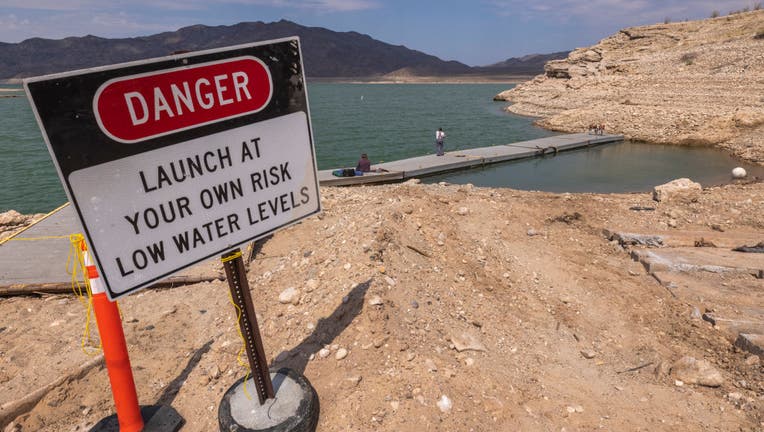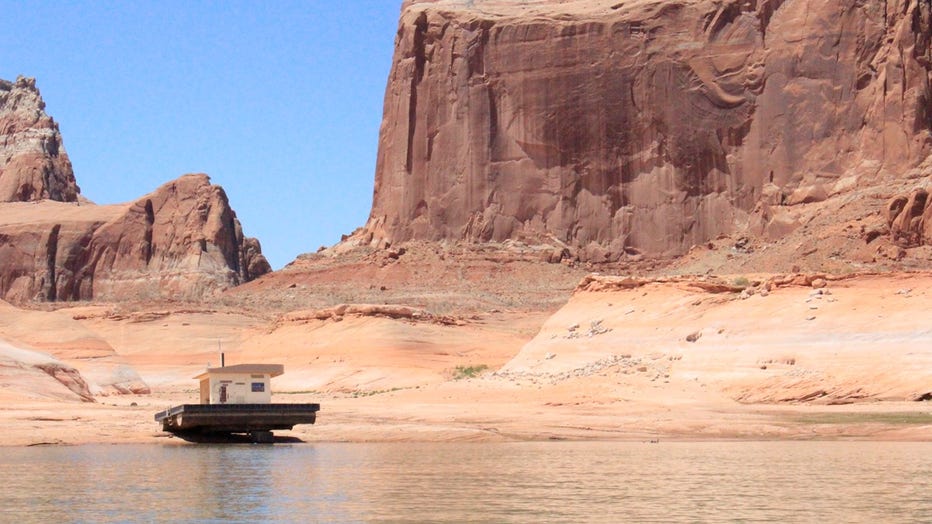Western states face federal water cuts as U.S. officials issue first-ever Level 1 shortage

A dock, which has become unusable as worsening drought drops the water level of Lake Mead to new historic low records, is seen at South Cove near the upper reaches of the reservoir on June 29, 2021, near Meadview, Arizona. (Photo by David McNew/Getty
WASHINGTON - U.S. officials declared the first-ever water shortage from a river that serves 40 million people in the West, triggering cuts to some Arizona farmers next year amid a gripping drought.
Water levels at the largest reservoir on the Colorado River — Lake Mead — have fallen to record lows. Along its perimeter, a white "bathtub ring" of minerals outlines where the high water line once stood, underscoring the acute water challenges for a region facing a growing population and a drought that is being worsened by hotter, drier weather brought on by climate change.
States, cities, farmers and others have diversified their water sources over the years, helping soften the blow of the upcoming cuts. But if current conditions persist — or intensify — additional cuts in coming years will be more deeply felt.
Lake Mead was formed by building Hoover Dam in the 1930s. It is one of several man-made reservoirs that store water from the Colorado River, which supplies drinking water, irrigation for farms and hydropower to Arizona, California, Colorado, Nevada, New Mexico, Utah, Wyoming and parts of Mexico.
But water levels at Lake Mead and Lake Powell, the river’s two largest reservoirs, have been falling for years and faster than experts predicted. Scorching temperatures and less melting snow in the spring have reduced the amount of water flowing from the Rocky Mountains, where the river originates before it snakes 1,450 miles (2,334 kilometers) southwest and into the Gulf of California.
"We’re at a moment where we’re reckoning with how we continue to flourish with less water, and it’s very painful," said Sarah Porter, director of the Kyl Center for Water Policy at Arizona State University.

Changing lake levels has left this floating restroom stranded on rock in Lake Powell. The bathroom, once located near Dominguez Butte has been moved to deeper water as of June 2021. (U.S. National Park Service)
Based on projections in the Colorado River Basin August 2021 24-Month Study, Lake Powell will operate in the Mid-Elevation Release Tier in water year 2022 (October 1, 2021 through September 30, 2022), and Lake Mead will operate in its first-ever Level 1 Shortage Condition in calendar year 2022 (January 1, 2022 through December 31, 2022).
From the Bureau of Reclamation:
Plans that have been developed over the past two decades lay out detailed operational rules for these critical Colorado River reservoirs:
- Based on projections in the study, Lake Powell will operate in the Mid-Elevation Release Tier in water year 2022 (October 1, 2021 through September 30, 2022), and Lake Mead will operate in its first-ever Level 1 Shortage Condition in calendar year 2022 (January 1, 2022 through December 31, 2022).
- Lake Powell Mid-Elevation Release Tier: The study projects Lake Powell’s January 1, 2022, elevation to be 3,535.40 feet - about 165 feet below full and about 45 feet above minimum power pool. Based on this projection, Lake Powell will operate in the Mid-Elevation Release Tier in water year 2022. Under this tier, Lake Powell will release 7.48 million acre-feet in water year 2022 without the potential for a mid-year adjustment in April 2022.
- Lake Mead Level 1 Shortage Condition: The study projects Lake Mead’s January 1, 2022, elevation to be 1,065.85 feet - about 9 feet below the Lower Basin shortage determination trigger of 1,075 feet and about 24 feet below the drought contingency plan trigger of 1,090 feet. Based on this projection, Lake Mead will operate in a Level 1 Shortage Condition for the first time ever. The required shortage reductions and water savings contributions under the 2007 Colorado River Interim Guidelines for Lower Basin Shortages and Coordinated Operations of Lake Powell and Lake Mead, 2019 Lower Basin Drought Contingency Plan and Minute 323 to the 1944 Water Treaty with Mexico are: Arizona: 512,000 acre-feet, which is approximately 18% of the state’s annual apportionment Nevada: 21,000 acre-feet, which is 7% of the state’s annual apportionment Mexico: 80,000 acre-feet, which is approximately 5% of the country’s annual allotment
- Arizona: 512,000 acre-feet, which is approximately 18% of the state’s annual apportionment
- Nevada: 21,000 acre-feet, which is 7% of the state’s annual apportionment
- Mexico: 80,000 acre-feet, which is approximately 5% of the country’s annual allotment
How is the river water shared?
Water stored in Lake Mead and Lake Powell is divvied up through legal agreements among the seven Colorado River basin states, the federal government, Mexico and others. The agreements determine how much water each gets, when cuts are triggered and the order in which the parties have to sacrifice some of their supply.
Under a 2019 drought contingency plan, Arizona, Nevada, California and Mexico agreed to give up shares of their water to maintain water levels at Lake Mead. The voluntary measures weren't enough to prevent the shortage declaration.
Who does Lake Mead serve?
Lake Mead supplies water to millions of people in Arizona, California, Nevada and Mexico.
Cuts for 2022 are triggered when predicted water levels fall below a certain threshold — 1,075 feet (328 meters) above sea level, or 40% capacity. Earlier this summer, Lake Mead's elevation hit its lowest point since being filled in the 1930s at 1,068 feet (326 meters).
Further rounds of cuts are triggered when projected levels sink to 1,050, 1,045 and 1,025 feet (320, 318 and 312 meters).
Eventually, some city and industrial water users could be affected.
Lake Powell's levels also are falling, threatening the roughly 5 billion kilowatt hours of electricity generated each year at the Glen Canyon Dam.
Colorado, New Mexico, Utah and Wyoming get water from tributaries and other reservoirs that feed into Lake Powell. Water from three reservoirs in those states has been drained to maintain water levels at Lake Powell and protect the electric grid powered by the Glen Canyon Dam.
Which states will be affected by the cuts?
In the U.S., Arizona will be hardest hit and lose 18% of its share from the river, or 512,000 acre-feet of water. That’s around 8% of the state’s total water use.
An acre-foot is enough water to supply one to two households a year.
Nevada will lose about 7% of its allocation, or 21,000 acre-feet of water. But it will not feel the shortage because of conservation efforts and alternative sources of water.
California is spared from immediate cuts because it has more senior water rights than Arizona and Nevada.
Mexico will see a reduction of roughly 5%, or 80,000 acre-feet.
Who in those states will see their water supply cut?
Farmers in central Arizona, who are among the state’s largest producers of livestock, dairy, alfalfa, wheat and barley, will bear the brunt of the cuts. Their allocation comes from water deemed "extra" by the agency that supplies water to much of the region, making them the first to lose it during a shortage.
As a result, the farmers will likely need to fallow land — as many already have in recent years because of persisting drought — and rely even more on groundwater, switch to water-efficient crops and find other ways to use less water.
Water suppliers have planned for the shortage declaration by diversifying and conserving their water supply, such as by storing water in underground basins. Still, water cuts make it harder to plan for the future.
The Central Arizona Project, which supplies water to Arizona’s major cities, will no longer bank river water or replenish some groundwater systems next year because of the cuts.
"It’s a historic moment where drought and climate change are at our door," said Chuck Cullom of the Central Arizona Project.
Cities like Las Vegas, Phoenix and Tucson, and Native American tribes are shielded from the first round of cuts.
Can the decline of Lake Mead be reversed?
Water levels at the reservoir have been falling since 1999 due to the dry spell enveloping the West and increased water demand. With weather patterns expected to worsen, experts say the reservoir may never be full again.
Though Lake Mead and Lake Powell could theoretically be refilled, planning for a hotter, drier future with less river water would be more prudent, said Porter of Arizona State University.
Continuing Coverage
- First water cuts in US West supply to hammer Arizona farmers
- July was Earth’s hottest month on record, NOAA says
- Recreation at risk as Lake Powell dips to historic low
___
Tune in to FOX 10 Phoenix for the latest news:
Sign up for FOX 10 email alerts, newsletters
Get breaking news alerts in the FOX 10 News app. It is FREE! Download for Apple iOS or Android.
The Associated Press receives support from the Walton Family Foundation for coverage of water and environmental policy. The AP is solely responsible for all content. For all of AP’s environmental coverage, visit

